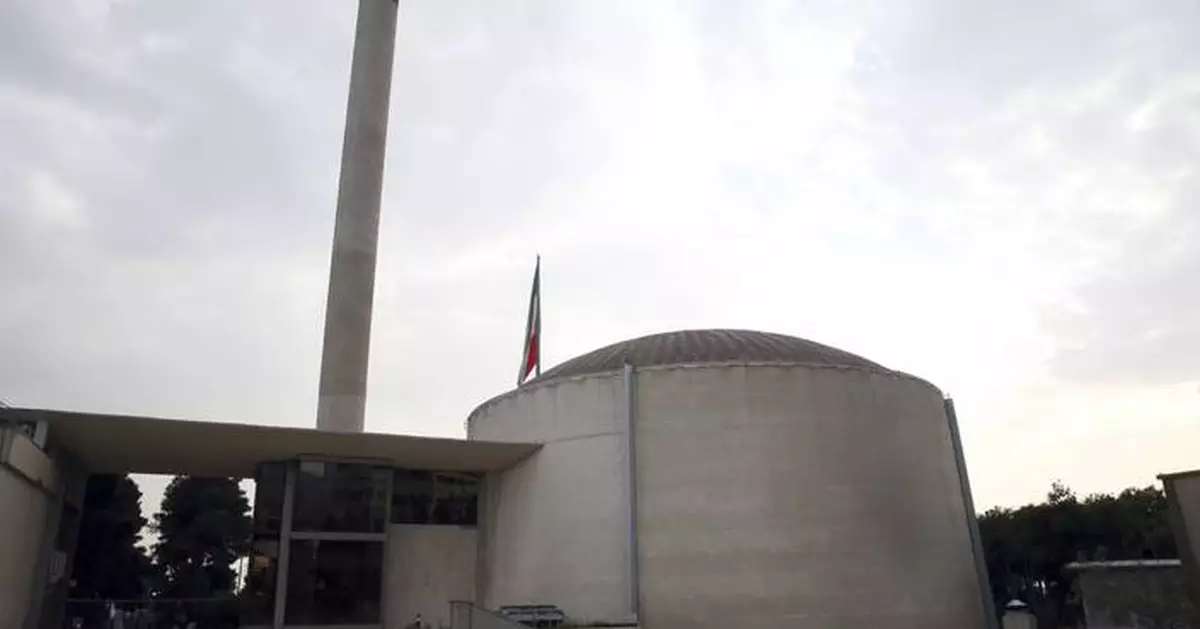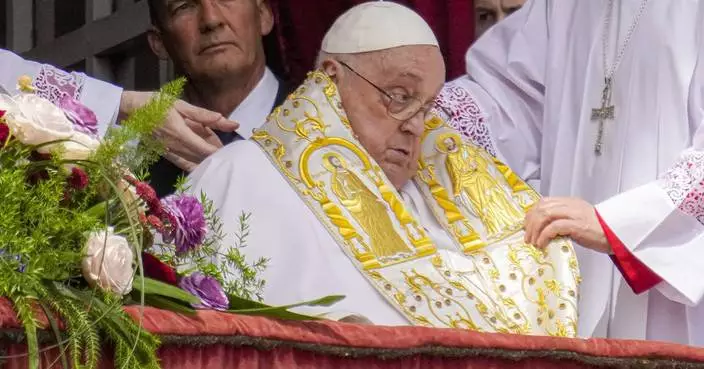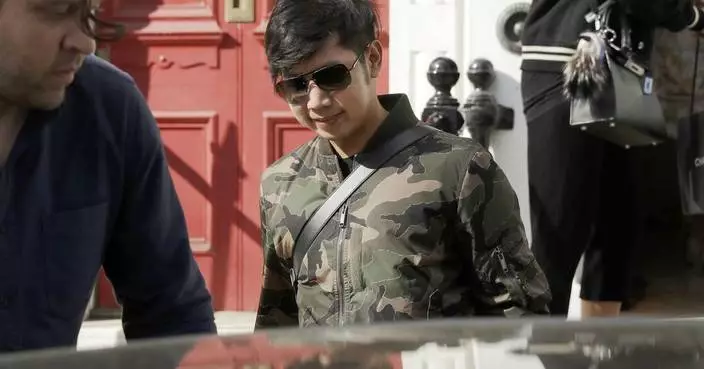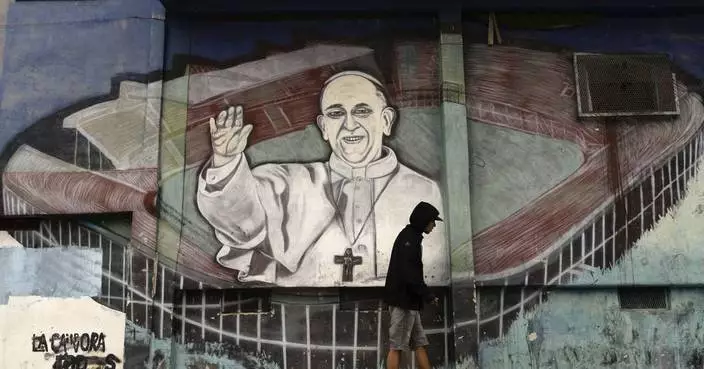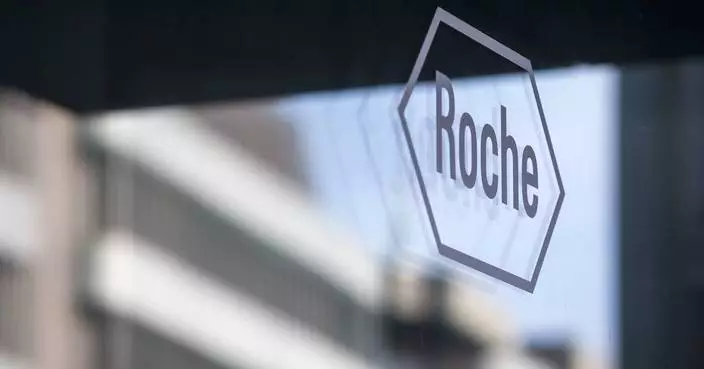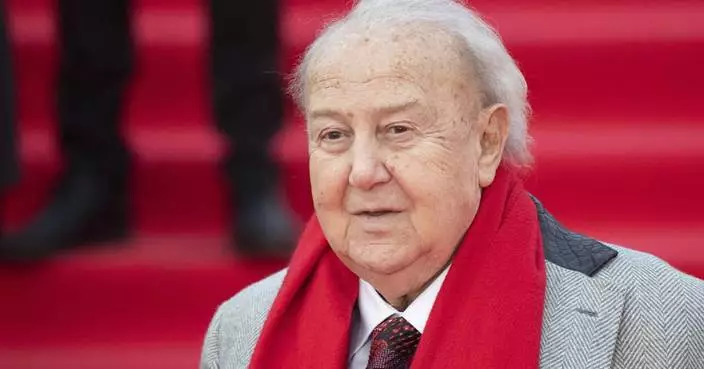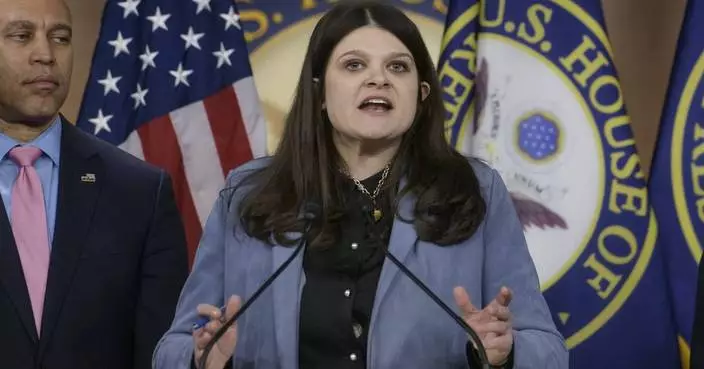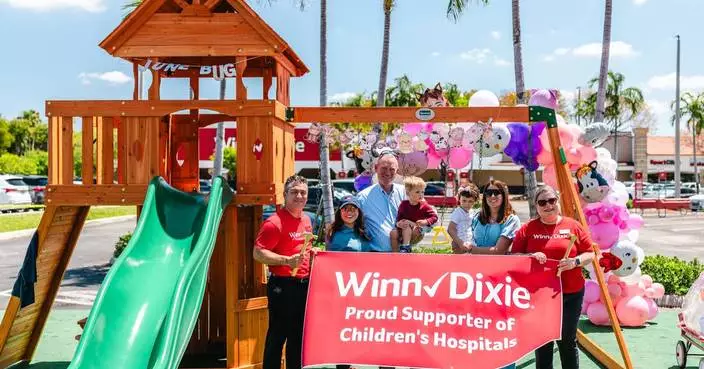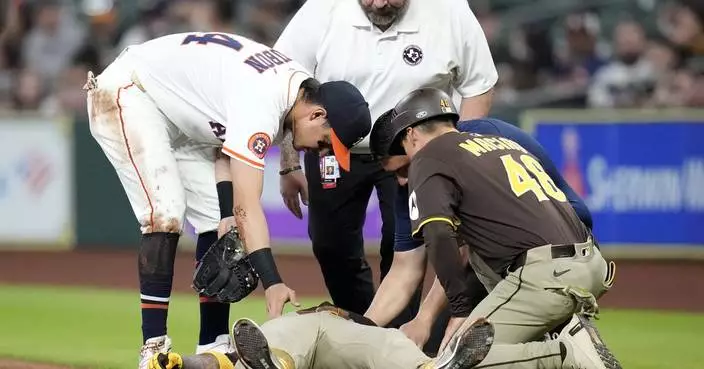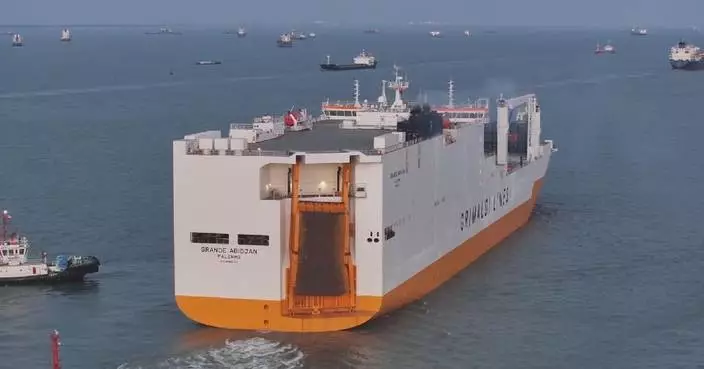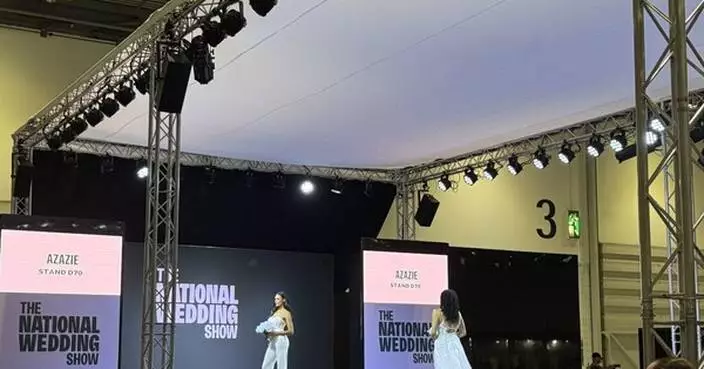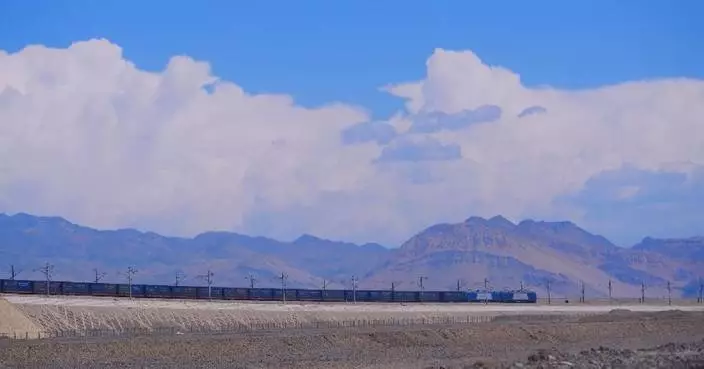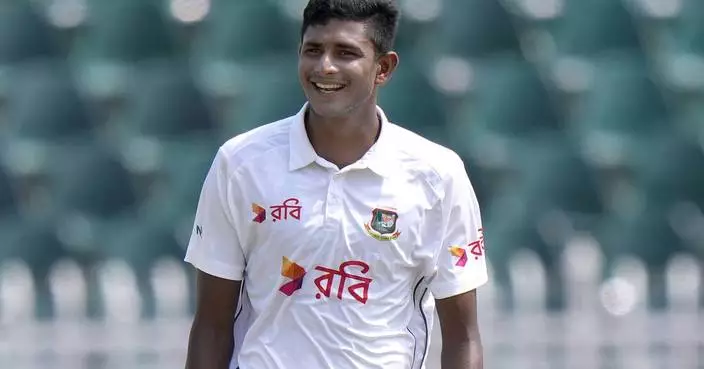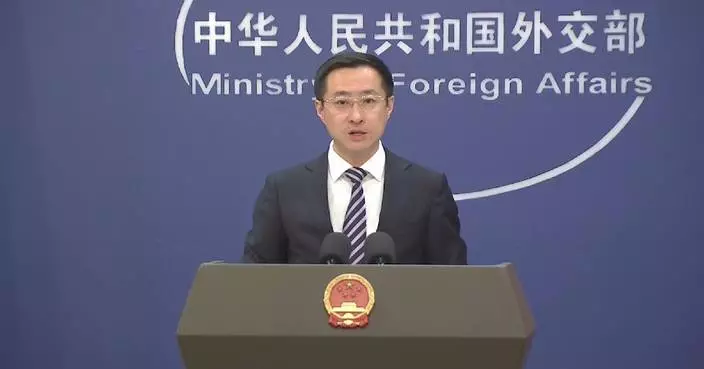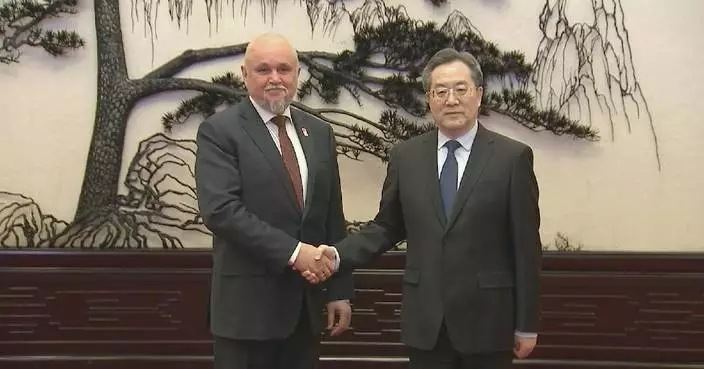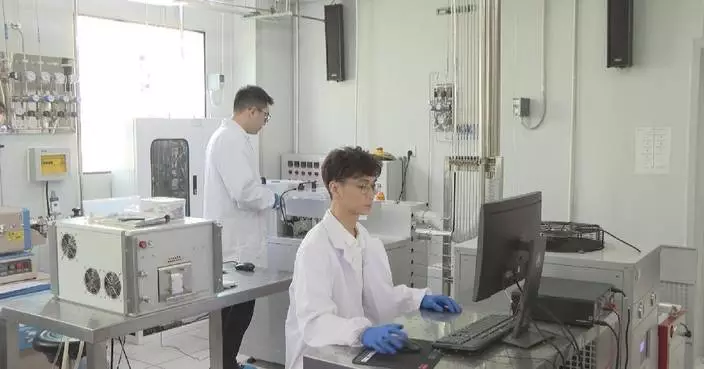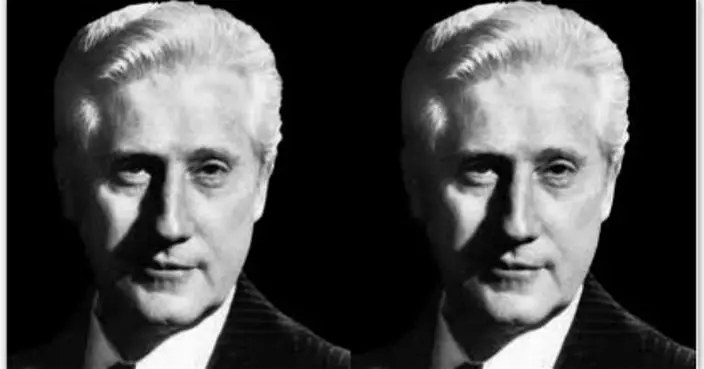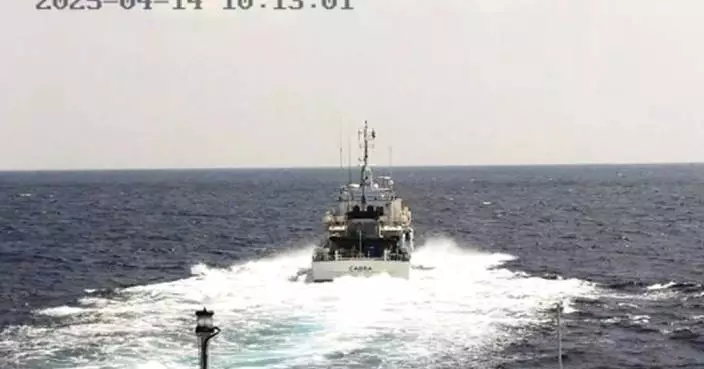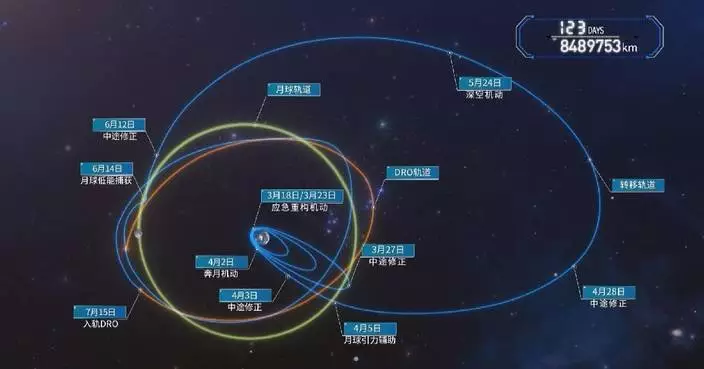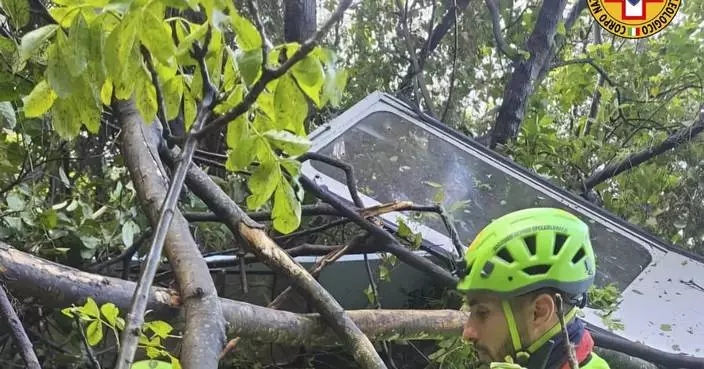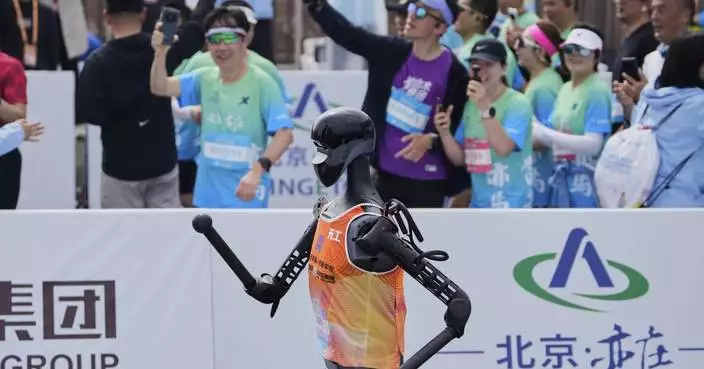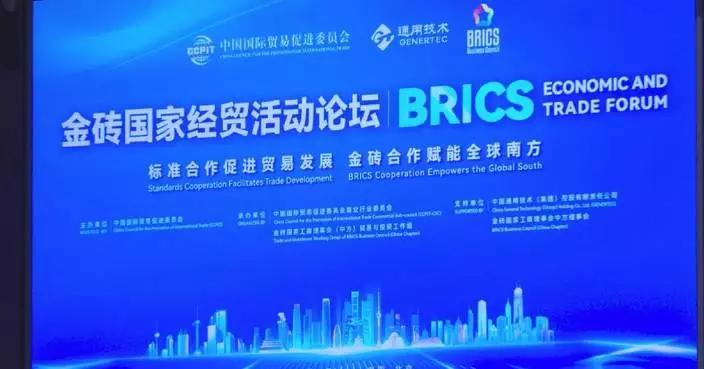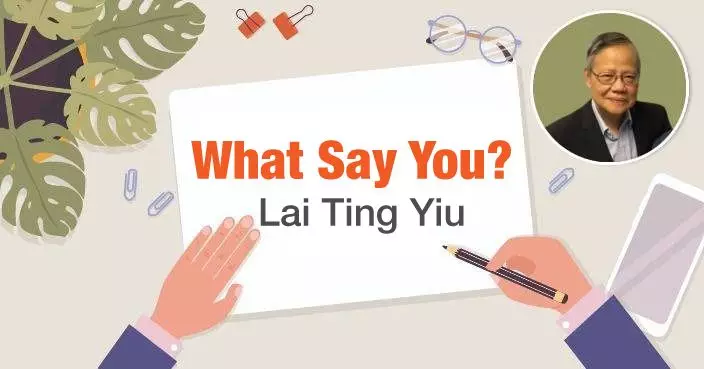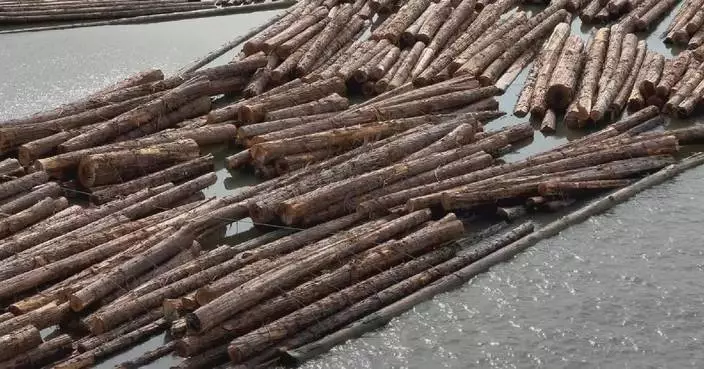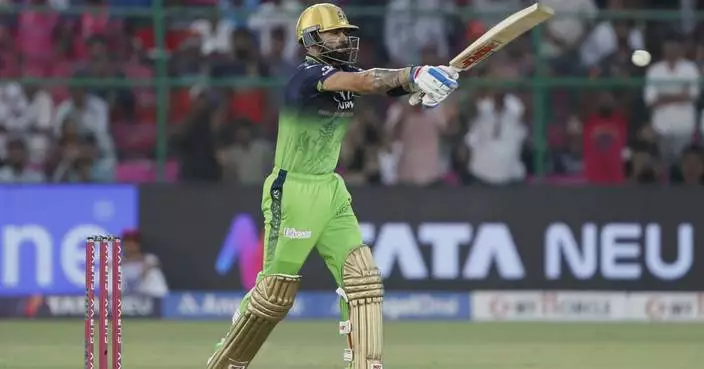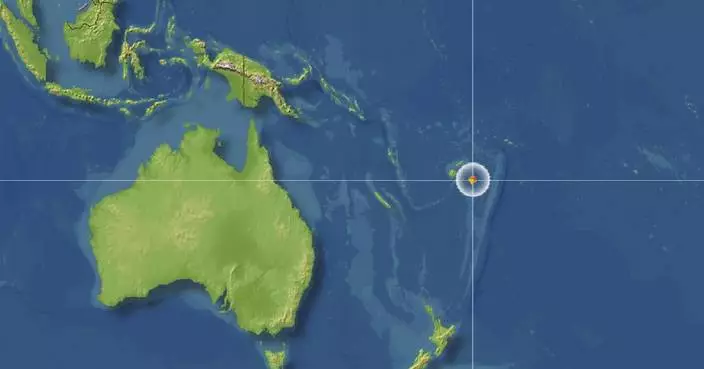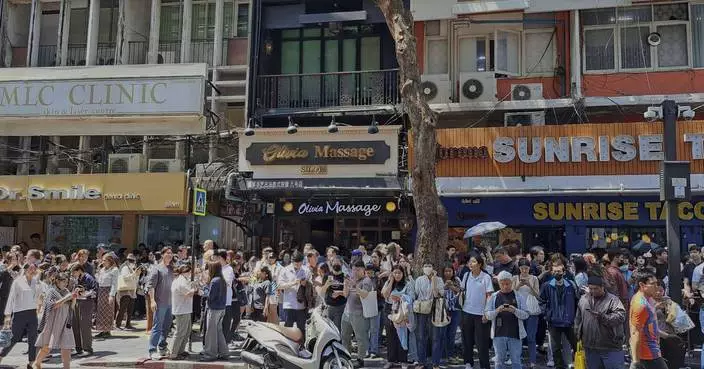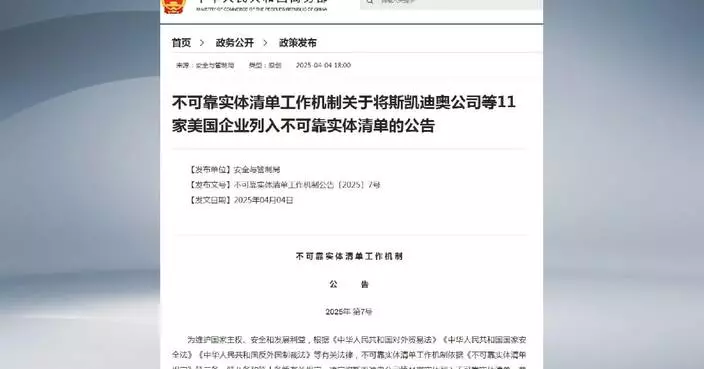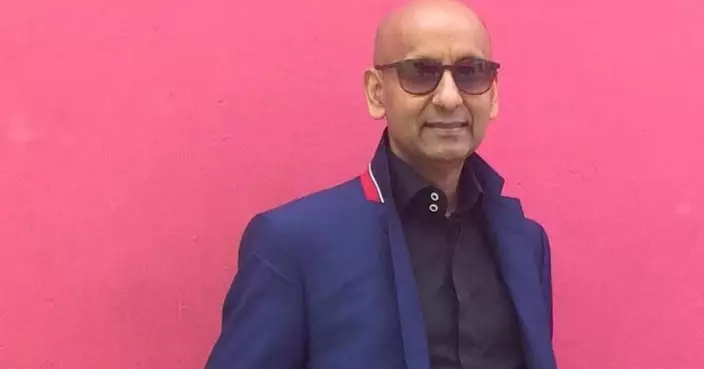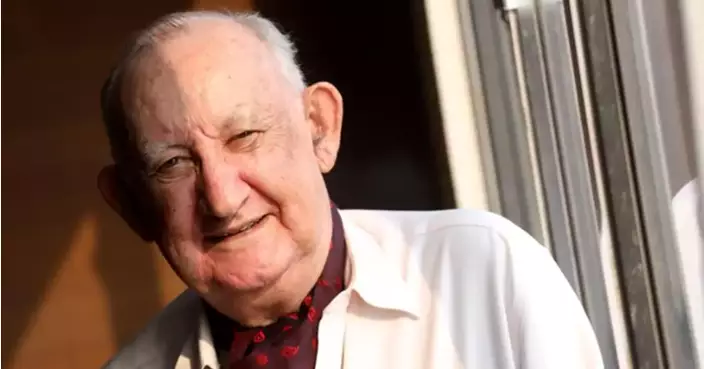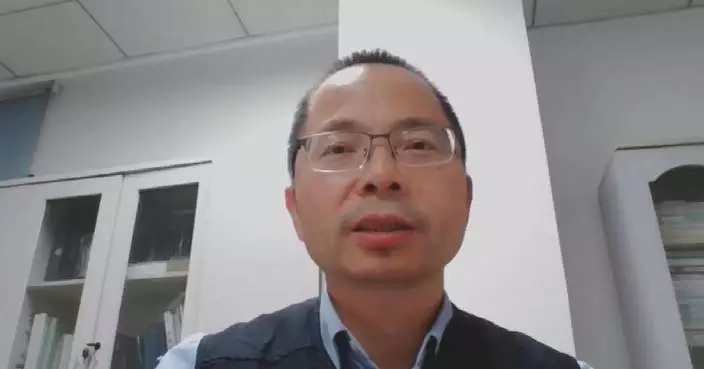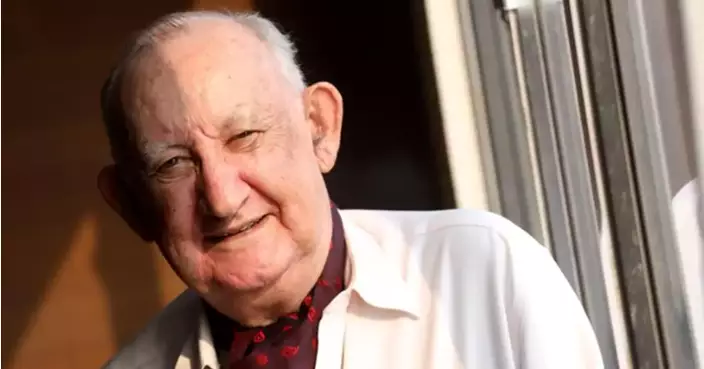Iran and the United States will hold a second round of talks in Rome on Saturday over Tehran’s rapidly advancing nuclear program.
The talks represent a milestone in the fraught relations between the two nations over Iran's program, which is enriching uranium close to weapons-grade levels.
Click to Gallery
Omani security personnel watch a convoy believed to be carrying U.S. Mideast envoy Steve Witkoff in Muscat, Oman, Saturday, April 12, 2025. (AP Photo/Fatima Shbair)
Omani security personnel watch a convoy believed to be carrying U.S. Mideast envoy Steve Witkoff in Muscat, Oman, Saturday, April 12, 2025. (AP Photo/Fatima Shbair)
In this photo released by the Iranian Presidency Office, President Masoud Pezeshkian, second right, listens to head of Atomic Energy Organization of Iran Mohammad Eslami as he visits an exhibition of Iran's nuclear achievements, in Tehran, Iran, Wednesday, April 9, 2025. (Iranian Presidency Office via AP)
In this photo released by the Iranian Presidency Office, President Masoud Pezeshkian, second right, listens to head of Atomic Energy Organization of Iran Mohammad Eslami as he visits an exhibition of Iran's nuclear achievements, in Tehran, Iran, Wednesday, April 9, 2025. (Iranian Presidency Office via AP)
FILE - The Natanz Uranium Enrichment Facility buildings, 200 miles (322 km) south of the capital Tehran, on March 30, 2005. (AP Photo/Vahid Salemi, File)
FILE - Iranian women walk past an anti-aircraft gun, at the conclusion of a rally to support Iran's nuclear programs, in front of the Natanz Uranium Enrichment Facility, some 200 miles (322 km) south of the capital Tehran, Iran, March 9, 2006. (AP Photo/Vahid Salemi, File)
FILE - US Secretary of State John Kerry, left, speaks during a meeting with Iranian Foreign Minister Mohammad Javad Zarif at United Nations headquarters, Sept. 26, 2015. (AP Photo/Craig Ruttle, File)
FILE- Iranians follow a truck, center, carrying the coffins of Hamas leader Ismail Haniyeh and his bodyguard who were killed in an assassination blamed on Israel on Wednesday, during their funeral ceremony at Enqelab-e-Eslami (Islamic Revolution) Sq. in Tehran, Iran, Aug. 1, 2024. (AP Photo/Vahid Salemi, FILE)
FILE - U.S. Secretary of State John Kerry, left, talks with Iranian Foreign Minister Mohammad Javad Zarif after the International Atomic Energy Agency (IAEA) verified that Iran has met all conditions under the nuclear deal, in Vienna, Jan. 16, 2016. (Kevin Lamarque/Pool via AP, File)
FILE - US Secretary of State John Kerry, left, listens to Iranian Foreign Minister Mohammad Javad Zarif, as they walk in the city of Geneva, Switzerland, Jan. 14, 2015, during a bilateral meeting ahead of the next round of nuclear discussions. (AP Photo/Keystone, Martial Trezzini, File)
FILE - An Iranian security official in protective clothing walks through part of the Uranium Conversion Facility just outside the Iranian city of Isfahan, March 30, 2005. (AP Photo/Vahid Salemi, File)
FILE - Iranian workers work at the ZPP (zirconium production plant) during President Mohammad Khatami's visit of the Uranium Conversion Facility, just outside the city of Isfahan, south of Tehran, Iran, in March 30, 2005. (AP Photo/Vahid Salemi, File)
FILE - Tehran's nuclear research reactor is seen at the headquarters of the Atomic Energy Organization of Iran, Sept. 1, 2014. (AP Photo/Vahid Salemi, File)
Here's a timeline of the tensions between the two countries over Iran's atomic program.
1967 — Iran takes possession of its Tehran Research Reactor under America’s “Atoms for Peace” program.
1979 — Shah Mohammad Reza Pahlavi, fatally ill, flees Iran as popular protests against him surge. Ayatollah Ruhollah Khomeini returns to Tehran and the Islamic Revolution sweeps him to power. Students seize the United States Embassy in Tehran, beginning the 444-day hostage crisis. Iran’s nuclear program goes fallow under international pressure.
August 2002 — Western intelligence services and an Iranian opposition group reveal Iran’s secret Natanz nuclear enrichment facility.
June 2003 — Britain, France and Germany engage Iran in nuclear negotiations.
October 2003 — Iran suspends uranium enrichment.
February 2006 — Iran announces it will restart uranium enrichment following the election of hard-line president Mahmoud Ahmadinejad. Britain, France and Germany walk out of stalled negotiations.
June 2009 — Iran’s disputed presidential election sees Ahmadinejad re-elected despite fraud allegations, sparking Green Movement protests and violent government crackdown.
October 2009 — Under President Barack Obama, the U.S. and Iran open a secret backchannel for messages in the sultanate of Oman.
July 2012 — U.S. and Iranian officials hold face-to-face secret talks in Oman.
July 14, 2015 — World powers and Iran announce a long-term, comprehensive nuclear agreement that limits Tehran's enrichment of uranium in exchange for the lifting of economic sanctions.
May 2018 — Trump unilaterally withdraws the U.S. from the nuclear agreement, calling it the “worst deal ever.” He says he’ll get better terms in new negotiations to stop Iran’s missile development and support for regional militias. Those talks don’t happen in his first term.
May 8, 2019 — Iran announces it will begin backing away from the accord. A series of regional attacks on land and at sea blamed on Tehran follow.
Jan. 3, 2020 — A U.S. drone strike in Baghdad kills Gen. Qassem Soleimani, the architect of Tehran’s proxy wars in the Middle East.
Jan. 8, 2020 — In retaliation for Soleimani’s killing, Iran launches a barrage of missiles at military bases in Iraq that are home to thousands of American and Iraqi troops. More than 100 U.S. service members suffer traumatic brain injuries. As Iran braces for a counterattack, the Revolutionary Guard shoots down a Ukrainian passenger plane shortly after takeoff from Tehran’s international airport, reportedly mistaking it for a U.S. cruise missile. All 176 people on board are killed.
July 2020 — A mysterious explosion tears apart a centrifuge production plant at Iran’s Natanz nuclear enrichment facility. Iran blames the attack on archenemy Israel.
April 6, 2021 — Iran and the U.S. under President Joe Biden begin indirect negotiations in Vienna over how to restore the nuclear deal. Those talks, and others between Tehran and European nations, fail to reach any agreement.
April 11, 2021 — A second attack within a year targets Iran’s Natanz nuclear site, again likely carried out by Israel.
April 16, 2021 — Iran begins enriching uranium up to 60% — its highest purity ever and a technical step from weapons-grade levels of 90%.
Feb. 24, 2022 – Russia launches its full-scale invasion of Ukraine. Moscow ultimately will come to rely on Iranian bomb-carrying drones in the conflict, as well as missiles.
July 17, 2022 — An adviser to Iran’s supreme leader, Kamal Kharrazi, says that Iran is technically capable of making a nuclear bomb, but has not decided whether to build one. His remarks will be repeated by others in the coming years as tensions grow.
Oct. 7, 2023 — Hamas militants from the Gaza Strip storm into Israel, killing 1,200 people and taking 250 others hostage. This begins the most intense war ever between Israel and Hamas. Iran, which has armed Hamas, offers support to the militants. Regional tensions spike.
Nov. 19, 2023 — Yemen’s Houthi rebels, long supported by Iran, seize the ship Galaxy Leader, beginning a monthslong campaign of attacks on shipping through the Red Sea corridor that the U.S. Navy describes as the most intense combat it has seen since World War II. The attacks mirror tactics earlier used by Iran.
April 14, 2024 — Iran launches an unprecedented direct attack on Israel, firing over 300 missiles and attack drones. Israel, working with a U.S.-led international coalition, intercepts much of the incoming fire.
April 19, 2024 — A suspected Israeli strike hits an air defense system by an airport in Isfahan, Iran.
July 31, 2024 – Ismail Haniyeh, a Hamas leader, is assassinated apparently by Israel during a visit to Tehran after the inauguration of reformist President Masoud Pezeshkian.
Sept. 27, 2024 — Israeli airstrike kills Hezbollah leader Hassan Nasrallah.
Oct. 1, 2024 — Iran launches its second direct attack on Israel, though a U.S.-led coalition and Israel shoot down most of the missiles.
Oct. 16, 2024 — Israel kills Hamas leader Yahya Sinwar in the Gaza Strip.
Oct. 26, 2024 — Israel openly attacks Iran for the first time, striking air defense systems and sites associated with its missile program.
Jan. 20, 2025 — Trump is inaugurated for his second term as president.
Feb. 7, 2025 – Iran's Supreme Leader Ayatollah Ali Khamenei says proposed talks with the U.S. are “not intelligent, wise or honorable.”
March 7, 2025 – Trump says he sent a letter to Khamenei seeking a new nuclear deal with Tehran.
March 15, 2025 — Trump launches intense airstrikes targeting Houthi rebels in Yemen, the last members of Iran's self-described “Axis of Resistance” capable of daily attacks.
April 7, 2025 — Trump announces the U.S. and Iran will hold direct talks in Oman. Iran says they'll be indirect talks, but confirms the meeting.
April 12, 2025 — First round of talks between Iran and the U.S. take place in Oman, ending with a promise to hold more talks after U.S. Mideast envoy Steve Witkoff and Iranian Foreign Minister Abbas Araghchi “briefly spoke” together.
April 17, 2025 — Next round of talks between the U.S. and Iran are scheduled to be held in Rome.

Omani security personnel watch a convoy believed to be carrying U.S. Mideast envoy Steve Witkoff in Muscat, Oman, Saturday, April 12, 2025. (AP Photo/Fatima Shbair)
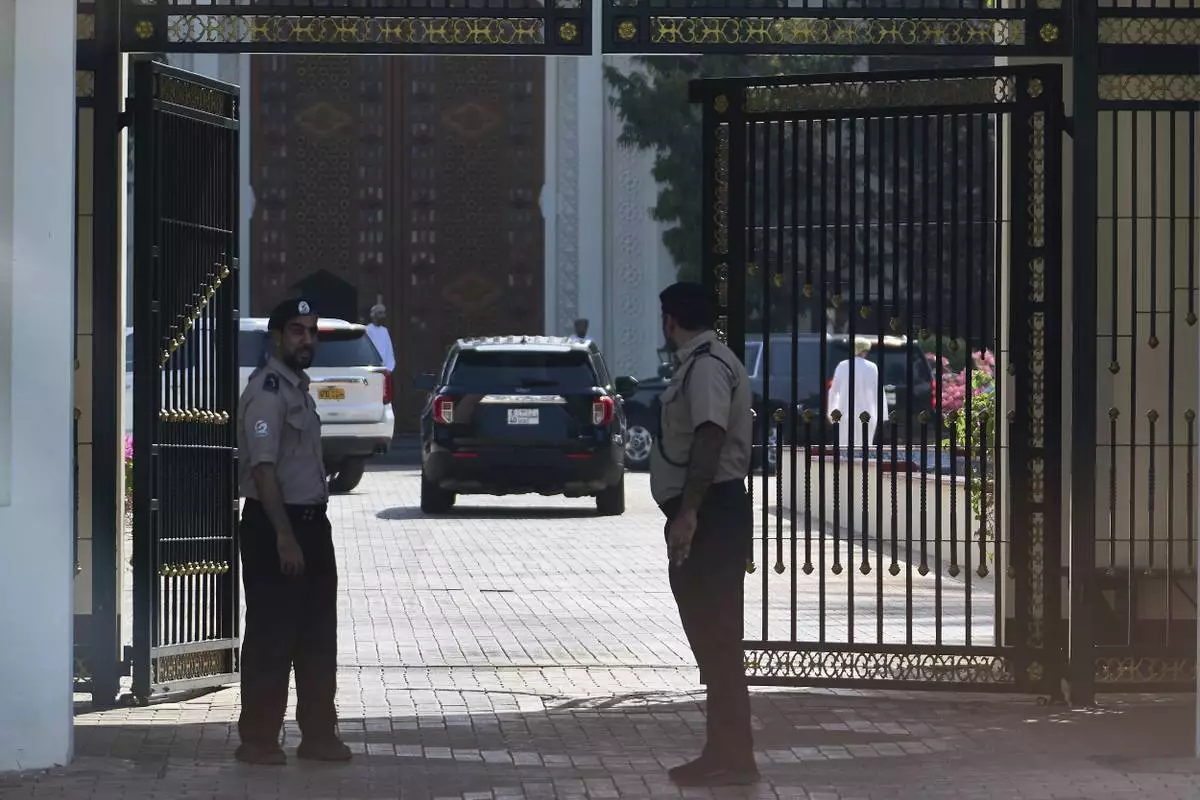
Omani security personnel watch a convoy believed to be carrying U.S. Mideast envoy Steve Witkoff in Muscat, Oman, Saturday, April 12, 2025. (AP Photo/Fatima Shbair)
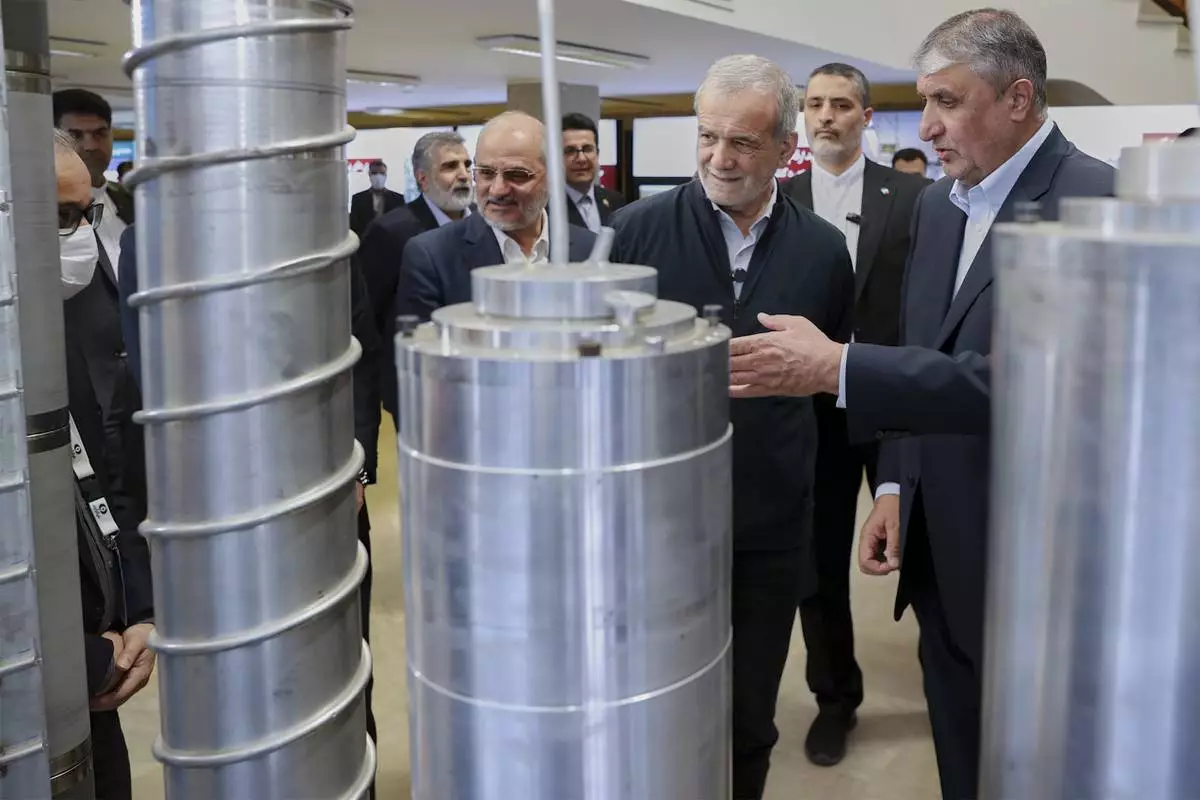
In this photo released by the Iranian Presidency Office, President Masoud Pezeshkian, second right, listens to head of Atomic Energy Organization of Iran Mohammad Eslami as he visits an exhibition of Iran's nuclear achievements, in Tehran, Iran, Wednesday, April 9, 2025. (Iranian Presidency Office via AP)
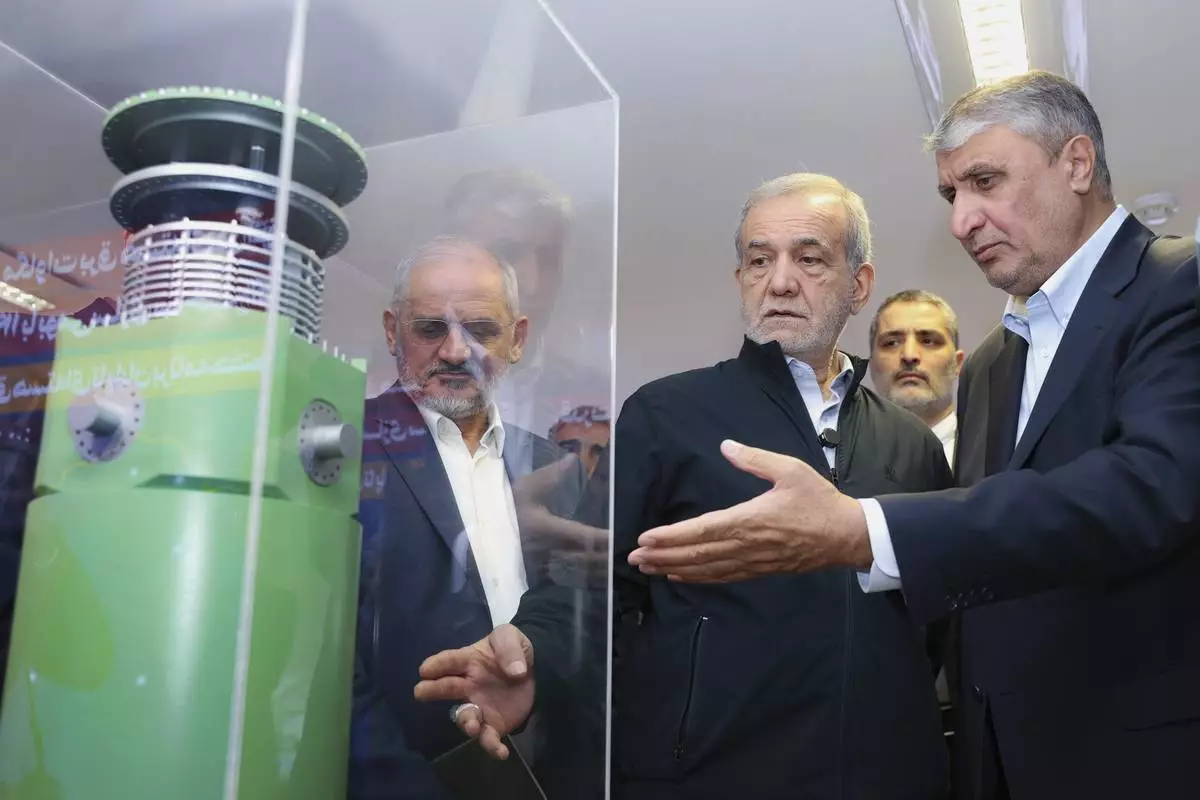
In this photo released by the Iranian Presidency Office, President Masoud Pezeshkian, second right, listens to head of Atomic Energy Organization of Iran Mohammad Eslami as he visits an exhibition of Iran's nuclear achievements, in Tehran, Iran, Wednesday, April 9, 2025. (Iranian Presidency Office via AP)

FILE - The Natanz Uranium Enrichment Facility buildings, 200 miles (322 km) south of the capital Tehran, on March 30, 2005. (AP Photo/Vahid Salemi, File)
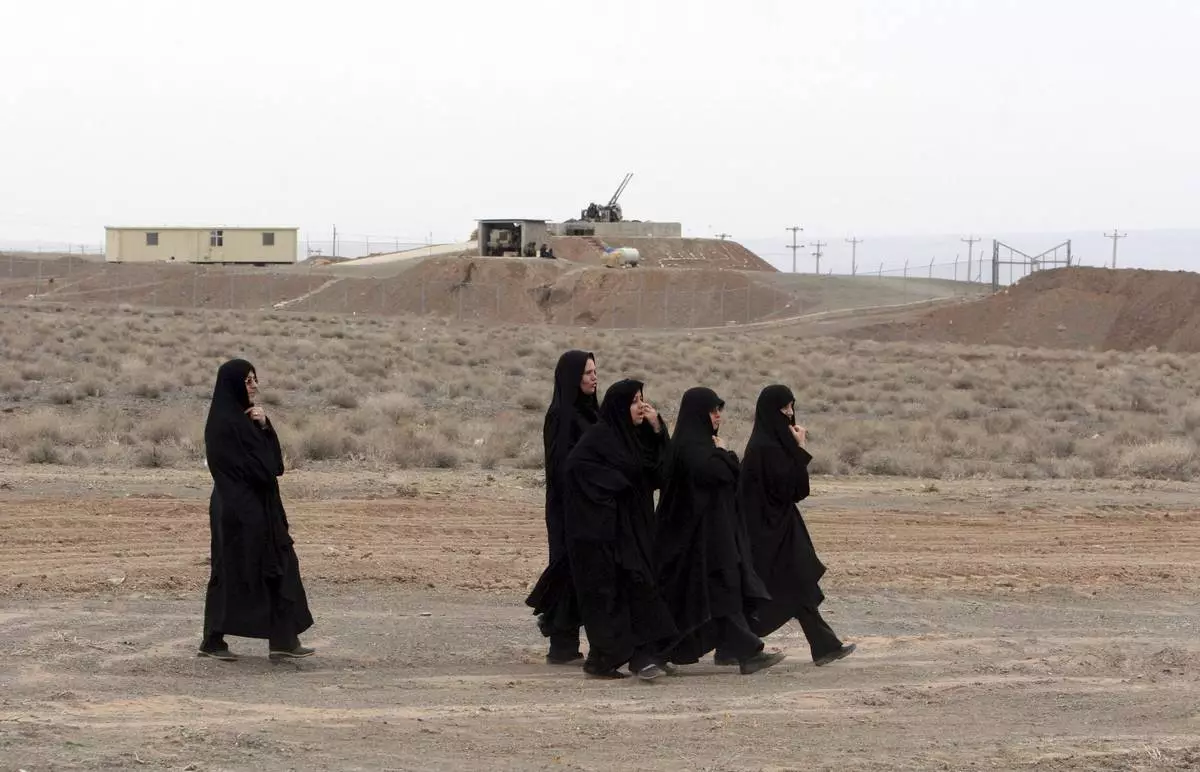
FILE - Iranian women walk past an anti-aircraft gun, at the conclusion of a rally to support Iran's nuclear programs, in front of the Natanz Uranium Enrichment Facility, some 200 miles (322 km) south of the capital Tehran, Iran, March 9, 2006. (AP Photo/Vahid Salemi, File)
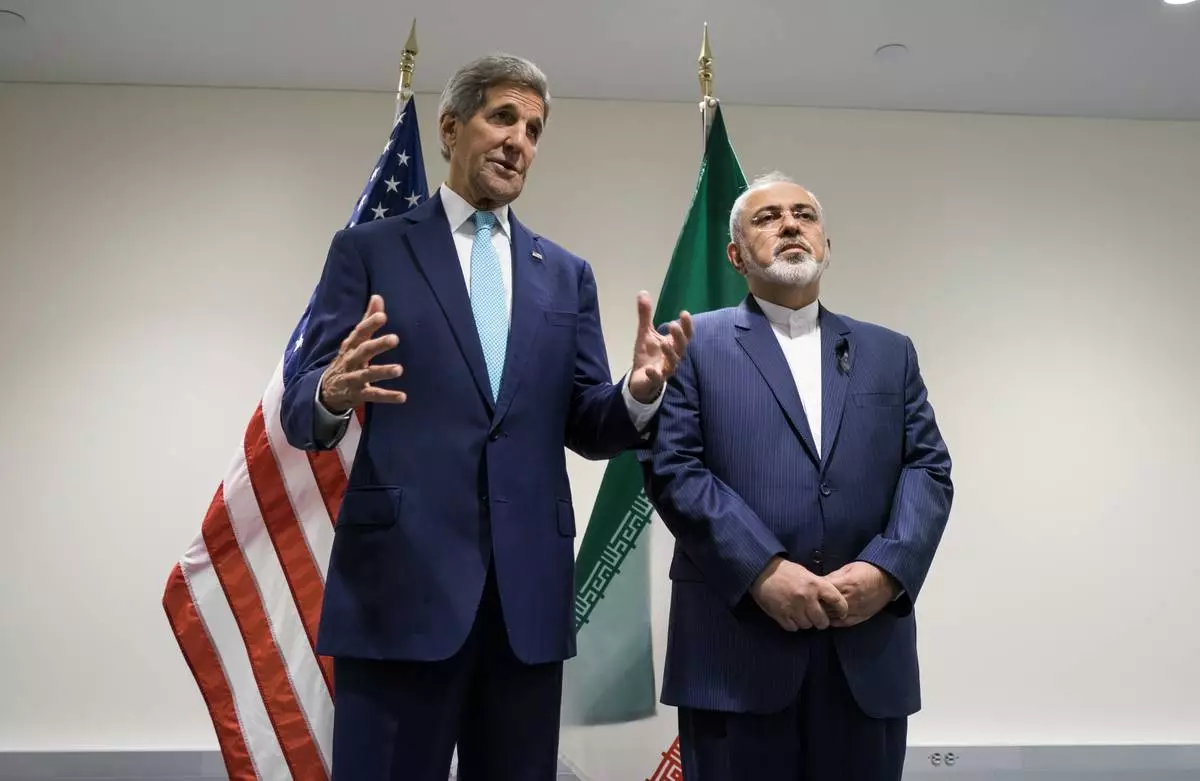
FILE - US Secretary of State John Kerry, left, speaks during a meeting with Iranian Foreign Minister Mohammad Javad Zarif at United Nations headquarters, Sept. 26, 2015. (AP Photo/Craig Ruttle, File)
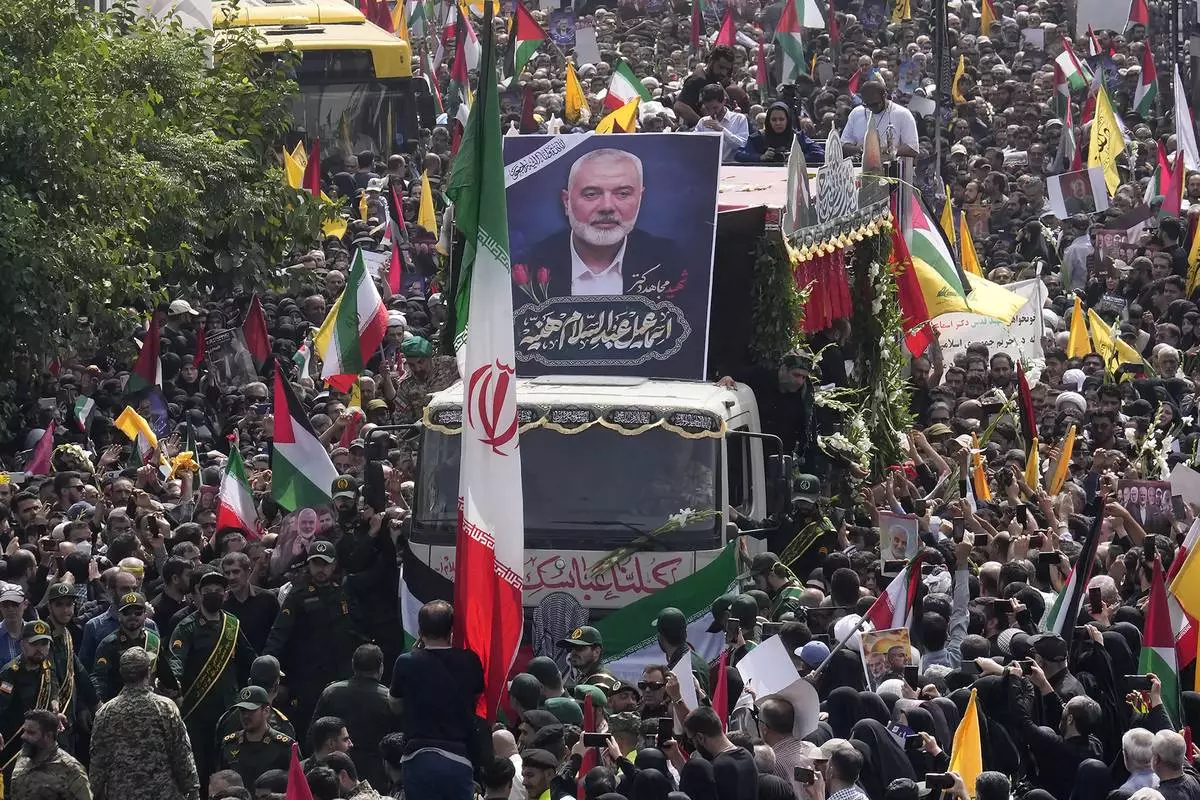
FILE- Iranians follow a truck, center, carrying the coffins of Hamas leader Ismail Haniyeh and his bodyguard who were killed in an assassination blamed on Israel on Wednesday, during their funeral ceremony at Enqelab-e-Eslami (Islamic Revolution) Sq. in Tehran, Iran, Aug. 1, 2024. (AP Photo/Vahid Salemi, FILE)
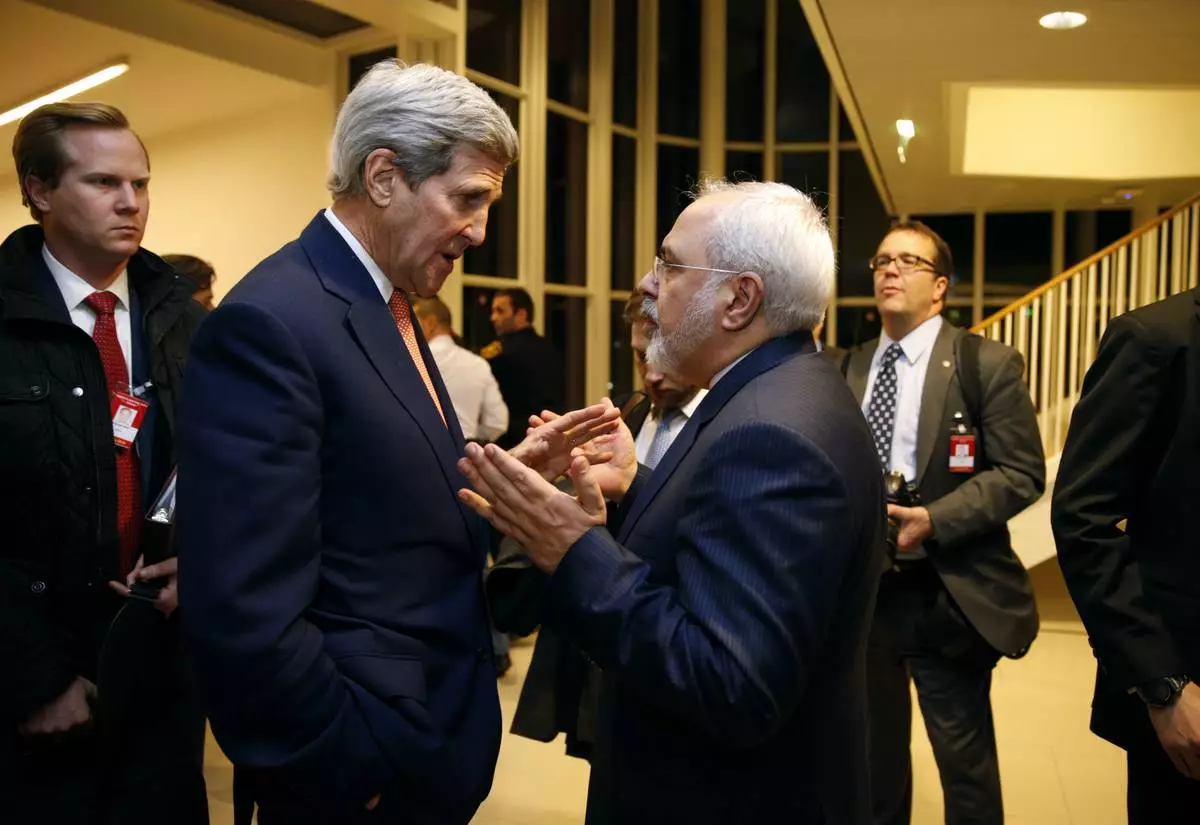
FILE - U.S. Secretary of State John Kerry, left, talks with Iranian Foreign Minister Mohammad Javad Zarif after the International Atomic Energy Agency (IAEA) verified that Iran has met all conditions under the nuclear deal, in Vienna, Jan. 16, 2016. (Kevin Lamarque/Pool via AP, File)
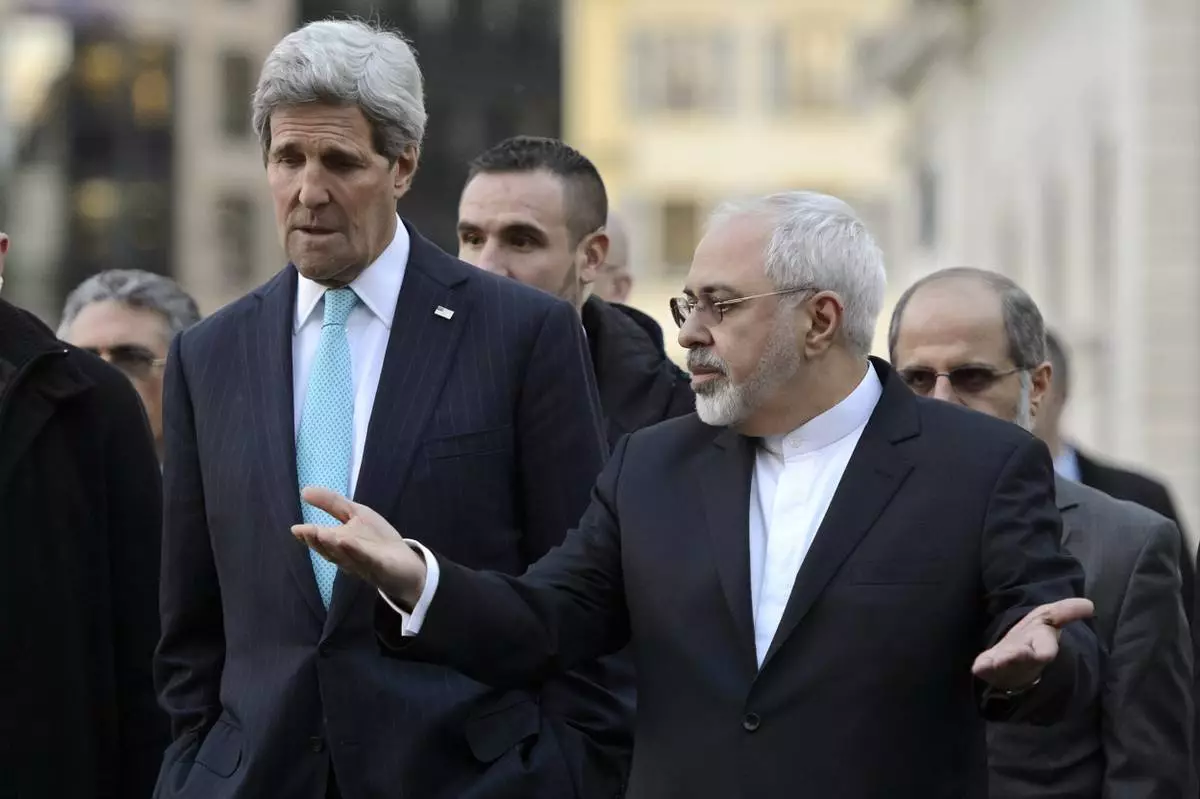
FILE - US Secretary of State John Kerry, left, listens to Iranian Foreign Minister Mohammad Javad Zarif, as they walk in the city of Geneva, Switzerland, Jan. 14, 2015, during a bilateral meeting ahead of the next round of nuclear discussions. (AP Photo/Keystone, Martial Trezzini, File)
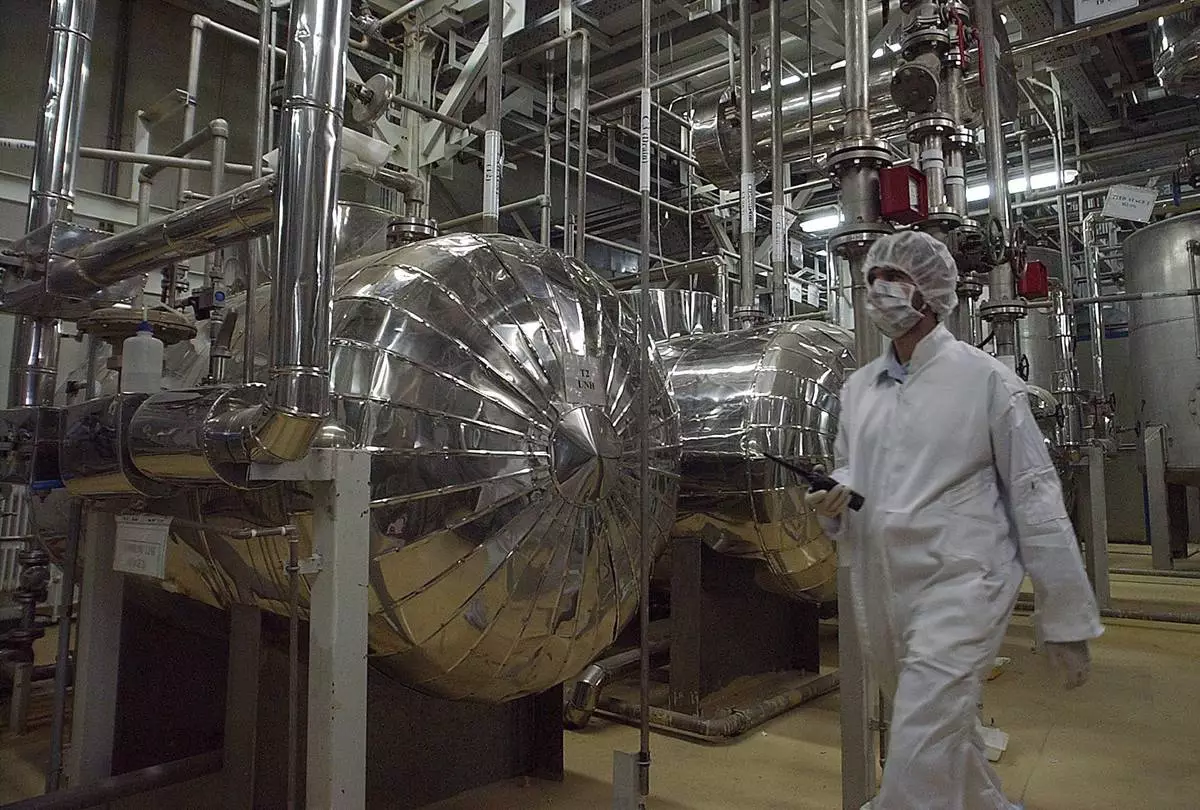
FILE - An Iranian security official in protective clothing walks through part of the Uranium Conversion Facility just outside the Iranian city of Isfahan, March 30, 2005. (AP Photo/Vahid Salemi, File)
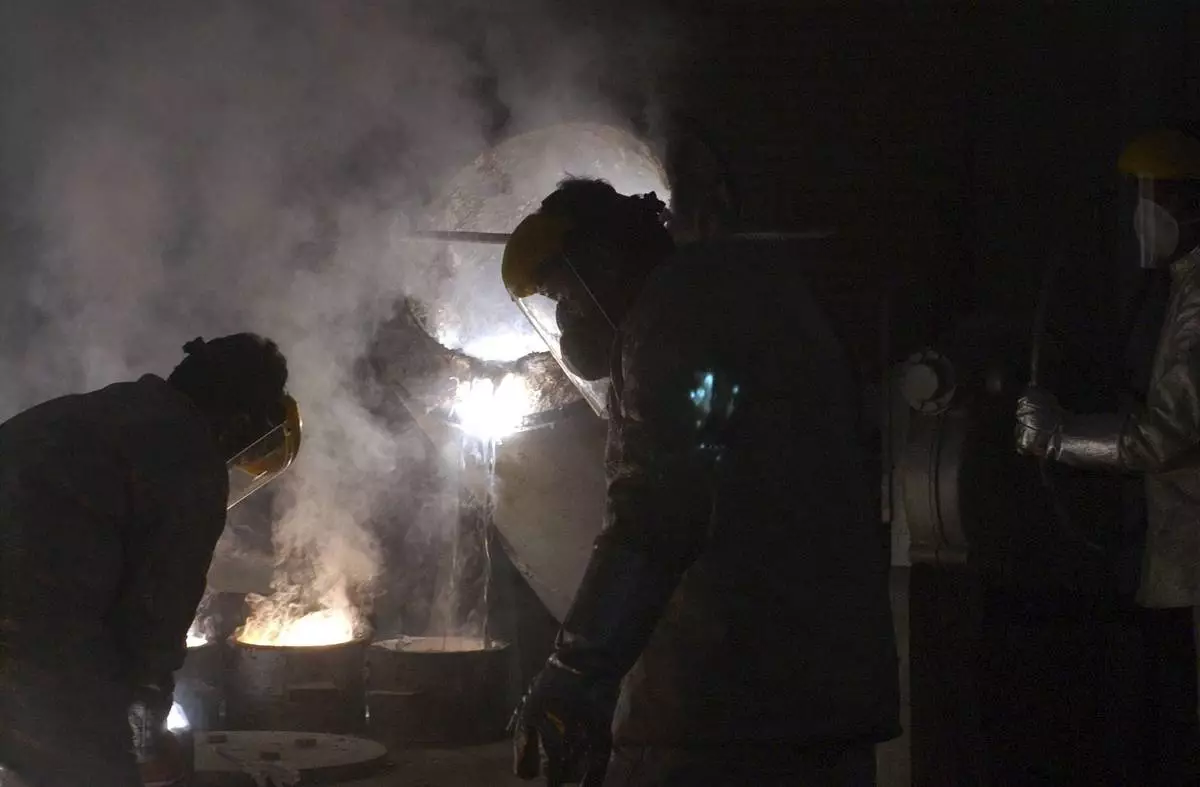
FILE - Iranian workers work at the ZPP (zirconium production plant) during President Mohammad Khatami's visit of the Uranium Conversion Facility, just outside the city of Isfahan, south of Tehran, Iran, in March 30, 2005. (AP Photo/Vahid Salemi, File)
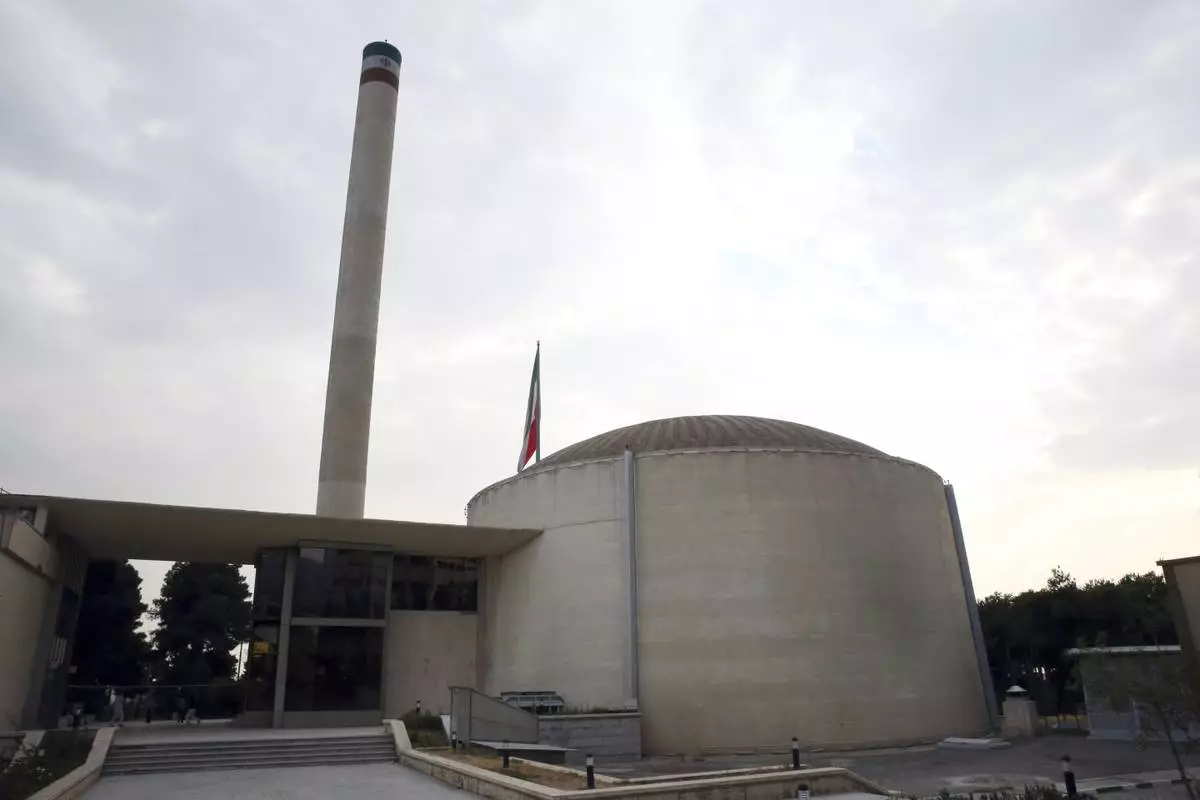
FILE - Tehran's nuclear research reactor is seen at the headquarters of the Atomic Energy Organization of Iran, Sept. 1, 2014. (AP Photo/Vahid Salemi, File)
BAGHDAD (AP) — The death of Pope Francis has sent shockwaves through Iraq’s Christian community, where his presence once brought hope after one of the darkest chapters in the country’s recent history.
His 2021 visit to Iraq, the first ever by a pope, came after years of conflict and displacement. Just a few years before that, many Iraqi Christians had fled their homes as Islamic State militants swept across the country.
Christian communities in Iraq, once numbering over a million, had already been reduced to a fraction of their former number by decades of conflict and mass emigration.
In Mosul, the site of some of the fiercest battles between Iraqi security forces and the Islamic State, Chaldean Archbishop Najeeb Moussa Michaeel recalled the pope’s visit to the battle-scarred city at a time when many visitors were still afraid to come as a moment of joy, “like a wedding for the people of Mosul."
“He broke this barrier and stood firm in the devastated city of Mosul, proclaiming a message of love, brotherhood, and peaceful coexistence,” Michaeel said.
As Francis delivered a speech in the city’s al-Midan area, which had been almost completely reduced to rubble, the archbishop said, he saw tears falling from the pope’s eyes.
Sa’dullah Rassam, who was among the Christians who fled from Mosul in 2014 in the face of the IS offensive, was also crying as he watched the pope leave the church in Midan that day.
Rassam had spent years displaced in Irbil, the seat of northern Iraq's semiautonomous Kurdish region, but was among the first Christians to return to Mosul, where he lives in a small house next to the church that Francis had visited.
As the pope's convoy was leaving the church, Rassam stood outside watching, tears streaming down his face. Suddenly the car stopped, and Francis got out to greet him.
“It was the best day of my life,” Rassam said. The pope's visit “made us feel loved and heard, and it helped heal our wounds after everything that happened here," he said.
The visit also helped to spur a drive to rebuild the city’s destroyed sites, including both Muslim and Christian places of worship.
“After the wide international media coverage of his visit, many parties began to invest again in the city. Today, Mosul is beginning to rise again,” Michaeel said. “You can see our heritage reappear in the sculptures, the churches and the streets.”
Chaldean Patriarch Cardinal Louis Raphael Sako told The Associated Press that Francis had built strong relationships with the Eastern rite churches — which are often forgotten by their Latin rite counterparts — and with Muslim communities.
The patriarch recalled urging Francis early in his papacy to highlight the importance of Muslim-Christian coexistence.
After the pope’s inaugural speech, in which he thanked representatives of the Jewish community for their presence, Sako said, “I asked him, ‘Why didn’t you mention Muslims?’... He said, ‘Tomorrow I will speak about Muslims,’ and indeed he did issue a statement the next day."
Francis went on to take “concrete steps to strengthen relationships” between Christians and Muslims through visits to Muslim-majority countries — including Egypt, the United Arab Emirates, Bahrain and Jordan as well as Iraq — Sako said. “He brought Muslims and Christians together around shared values.”
His three-day visit to Iraq “changed Iraq’s face — it opened Iraq to the outside world,” Sako said, while “the people loved him for his simplicity and sincerity.”
The patriarch said that three months before the pope’s death, he had given him a gift of dates from Iraq, and Francis responded that he “would never forget Iraq and that it was in his heart and in his prayers.”
During his visit to Iraq, Francis held a historic meeting with the country's top Shiite cleric, Grand Ayatollah Ali al-Sistani, at the latter’s home in Najaf.
Sistani’s office in a statement Monday expressed “deep sorrow” at the pope’s death, saying he was “greatly respected by all for his distinguished role in serving the causes of peace and tolerance, and for expressing solidarity with the oppressed and persecuted across the globe.”
The meeting between the two religious leaders had helped to “promote a culture of peaceful coexistence, reject violence and hatred, and uphold values of harmony based on safeguarding rights and mutual respect among followers of different religions and intellectual traditions,” it said.
In Irbil, Marvel Rassam recalled joining the crowds who packed into a stadium to catch a glimpse of the pope.
The visit brought a sense of unity, Rassam said, “as everyone attended to see him, and not only the Catholics.”
“He was our favorite pope, not only because he was the first to visit Iraq, but he was also very special and unique for his humility and inclusivity,” he said.
At St. Joseph Chaldean Cathedral in Baghdad, where Francis led a Mass during his 2021 visit, church pastor Nadhir Dako said the pope's visit had carried special weight because it came at a time when Christians in Iraq were still processing the trauma of the IS attacks.
“We, the Christians, were in very difficult situation. There was frustration due to the forcible migration and the killing that occurred," Dako said. "The visit by the pope created a sort of determination for all Iraqis to support their Christian brothers.”
——-
Martany reported from Irbil, Iraq.
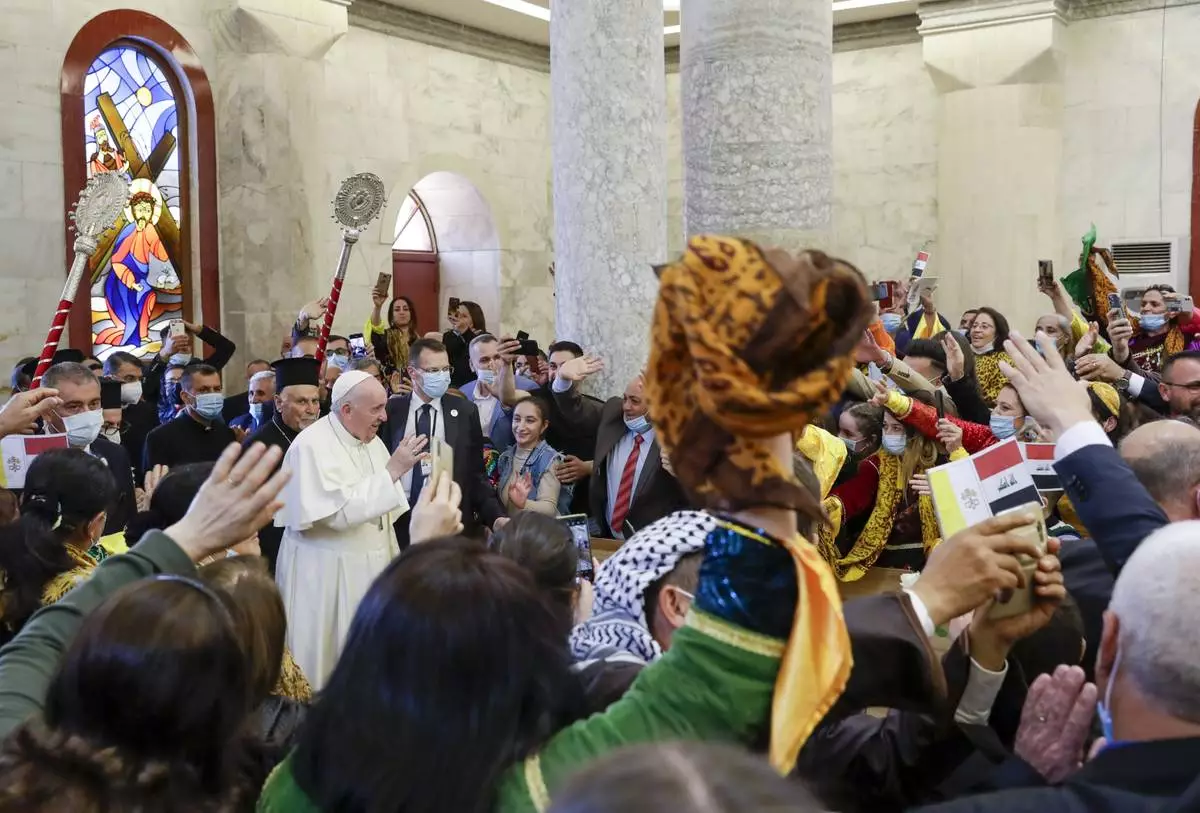
FILE.- Pope Francis arrives at a meeting with the Qaraqosh community at the Church of the Immaculate Conception, in Qaraqosh, Iraq, Sunday, March 7, 2021. (AP Photo/Andrew Medichini,File)

FILE.- Women wait outside the Chaldean Cathedral of Saint Joseph, in Baghdad, Iraq, Saturday, March 6, 2021, where Pope Francis, depicted on a giant poster at their back, is concelebrating a mass. (AP Photo/Andrew Medichini,File)
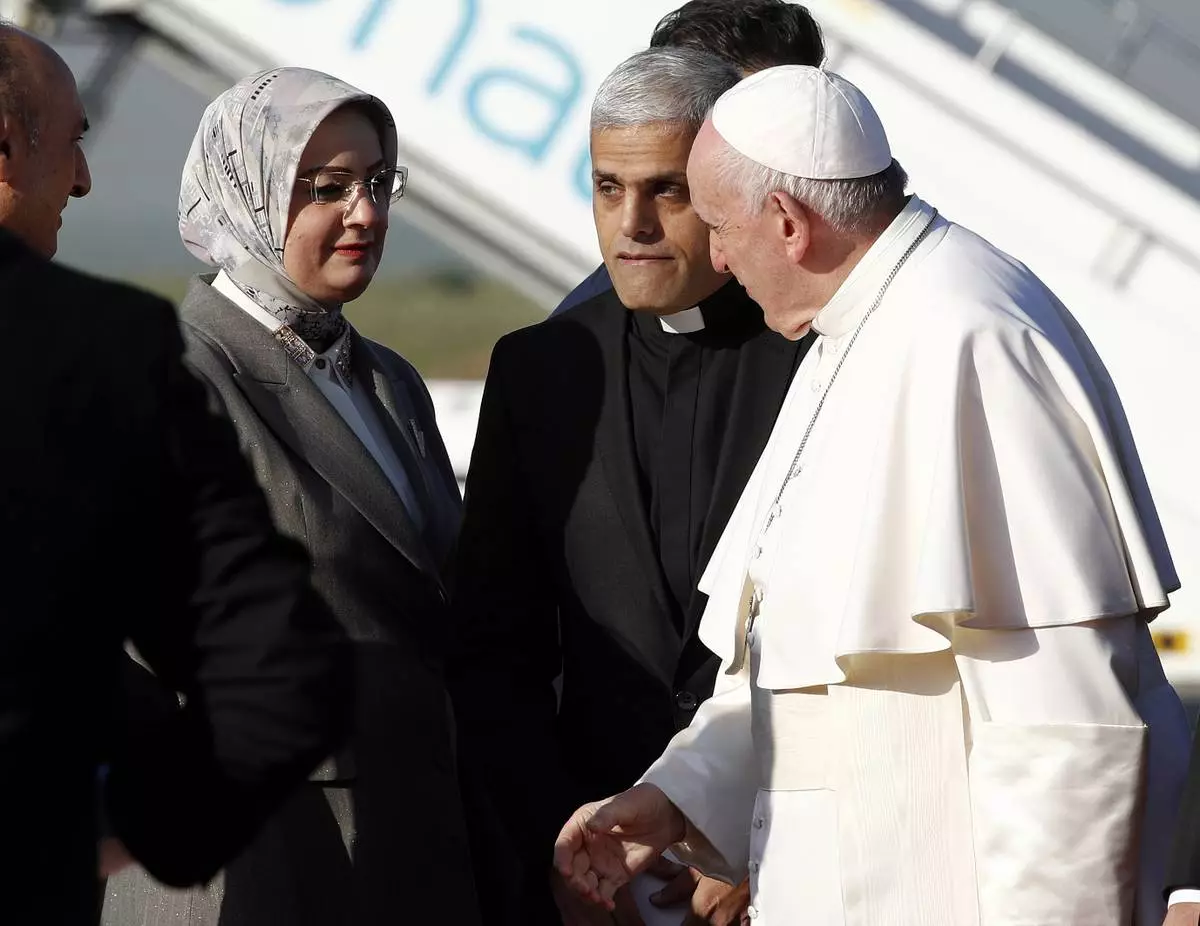
FILE - Pope Francis is welcomed as he arrives at Irbil airport, Iraq, March 7, 2021. (AP Photo/Hadi Mizban, file)
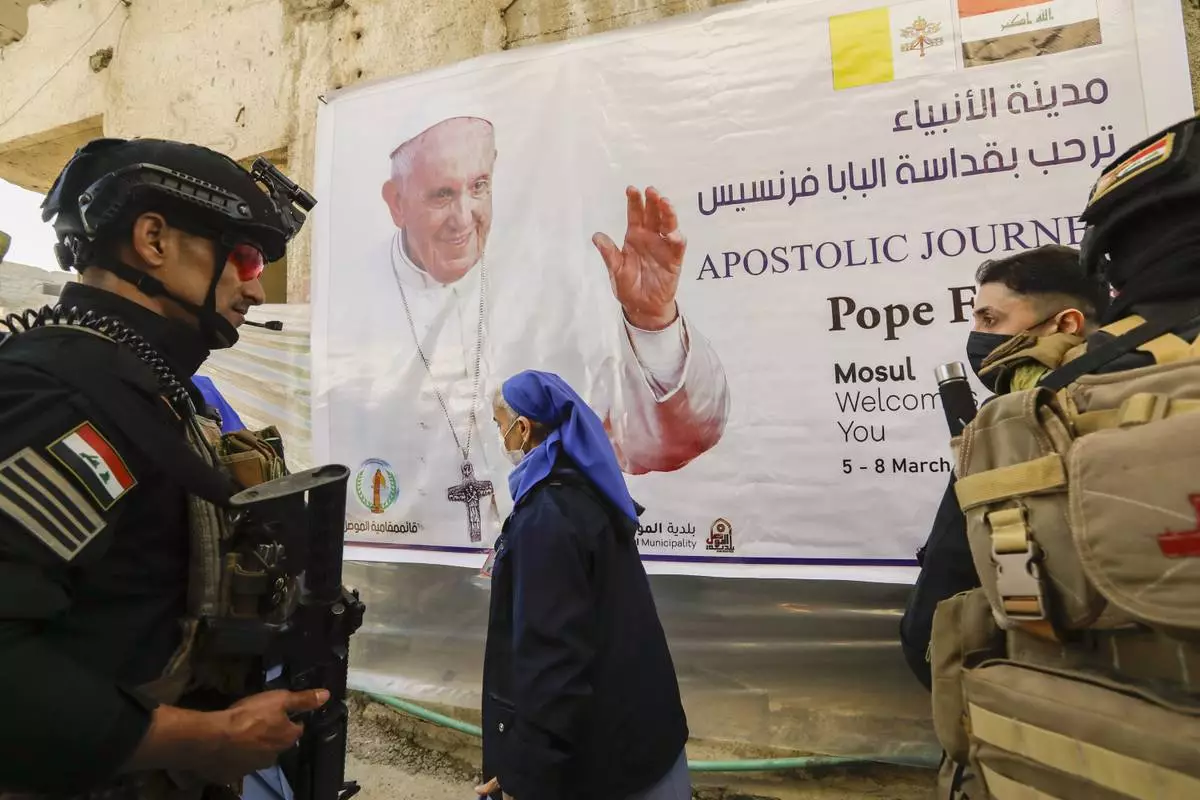
FILE.- Iraqi security forces deploy in Mosul, northern Iraq, once the de-facto capital of IS, where Pope Francis will pray for the victims of war at Hosh al-Bieaa Church Square, Sunday, March 7, 2021. (AP Photo/Andrew Medichini,File)
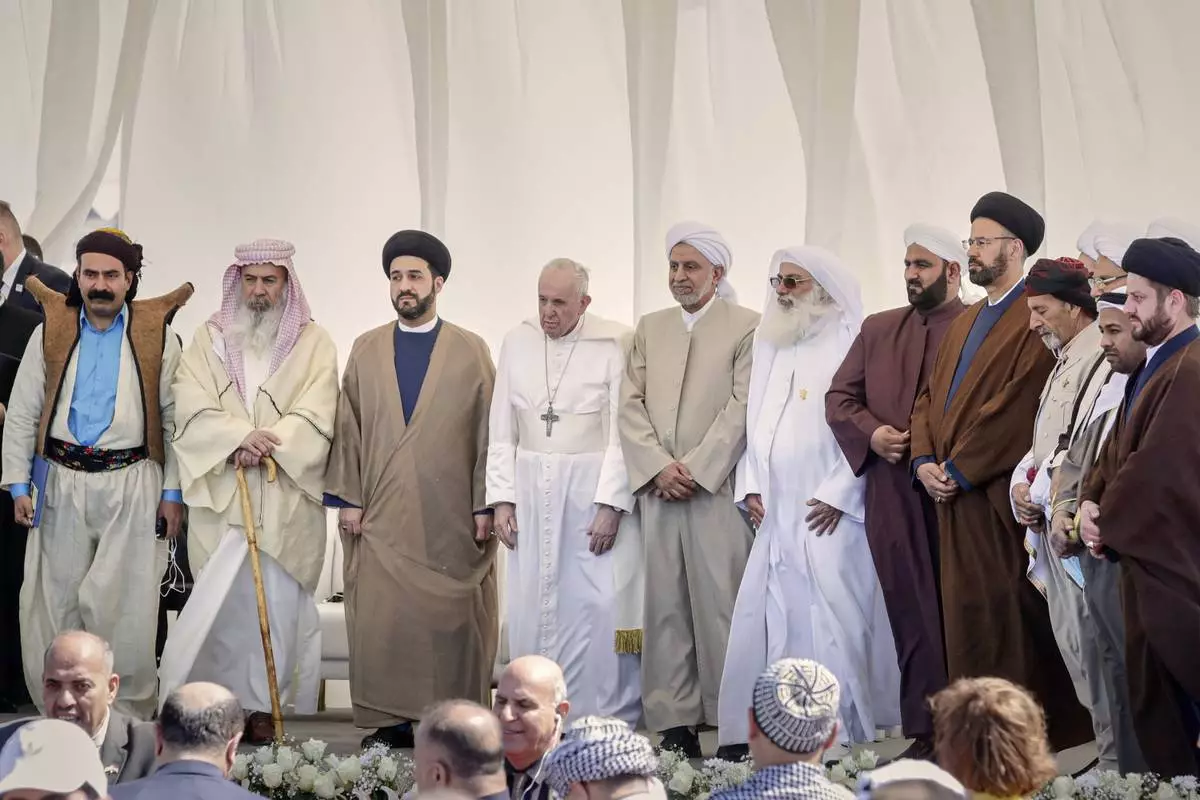
FILE.- Pope Francis stands with religious leaders during an interreligious meeting near the archaeological area of the Sumerian city-state of Ur, 20 kilometers south-west of Nasiriyah, Iraq, Saturday, March 6, 2021.(AP Photo/Andrew Medichini,File)
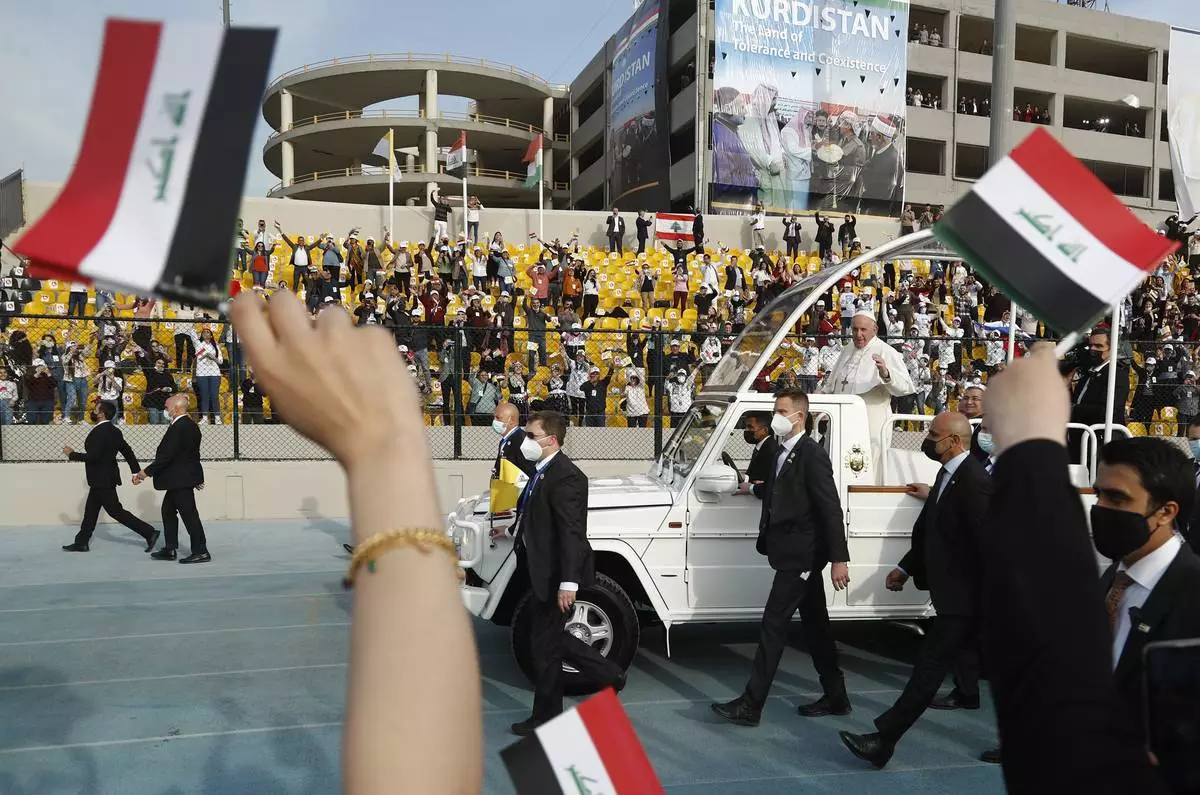
FILE.- Pope Francis waves as he arrives for an open air Mass at a stadium in Irbil, Iraq, Sunday, March 7, 2021. (AP Photo/Hadi Mizban,File)
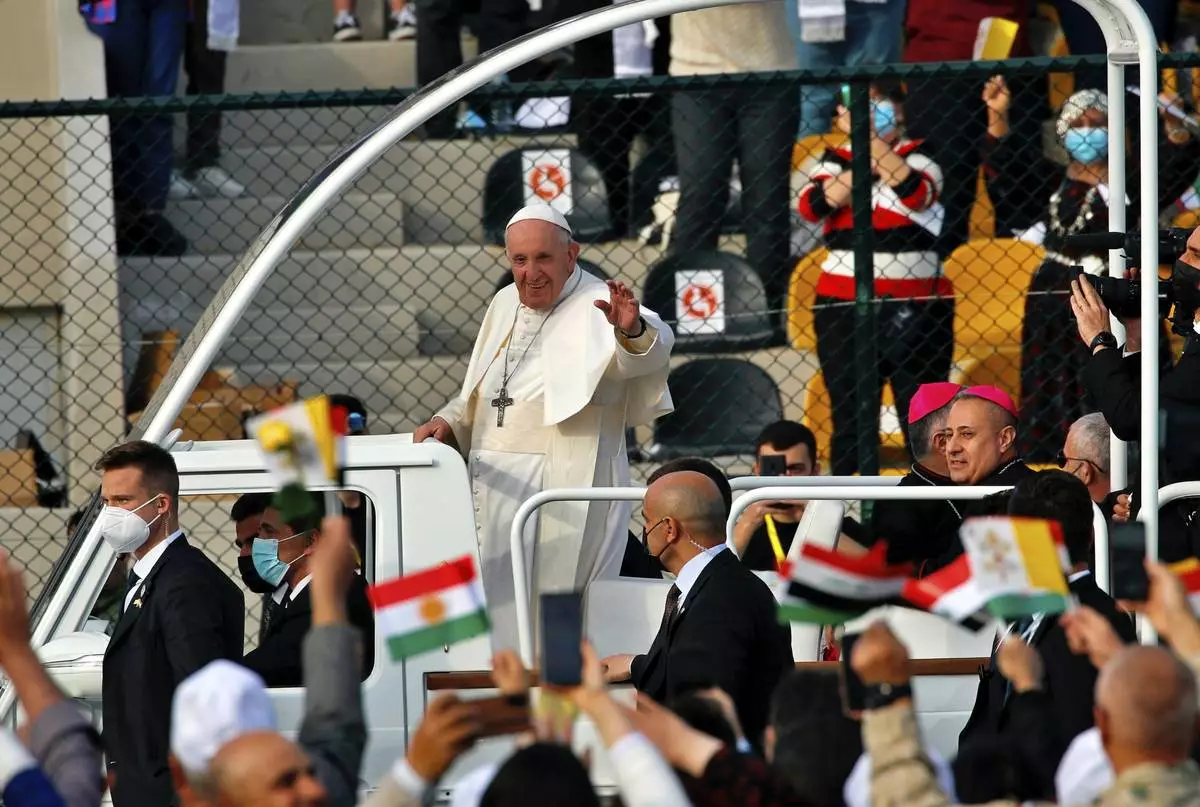
FILE - Pope Francis waves as he arrives for an open air Mass at a stadium in Irbil, Iraq, March 7, 2021. (AP Photo/Hadi Mizban, file)
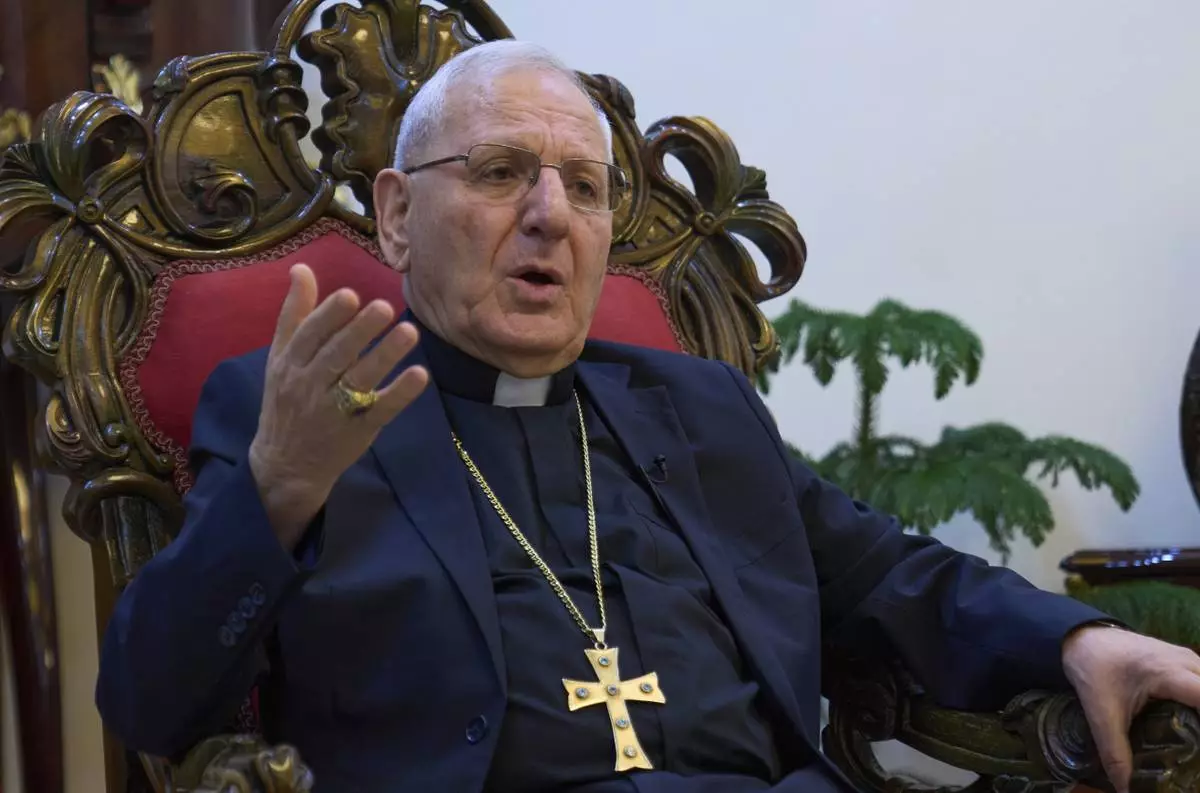
Louis Sako, patriarch of Iraq's Chaldean Catholic Church, speaks during an interview with The Associated Press in Baghdad, Iraq, Monday, April 21, 2025. (AP Photo/Hadi Mizban)
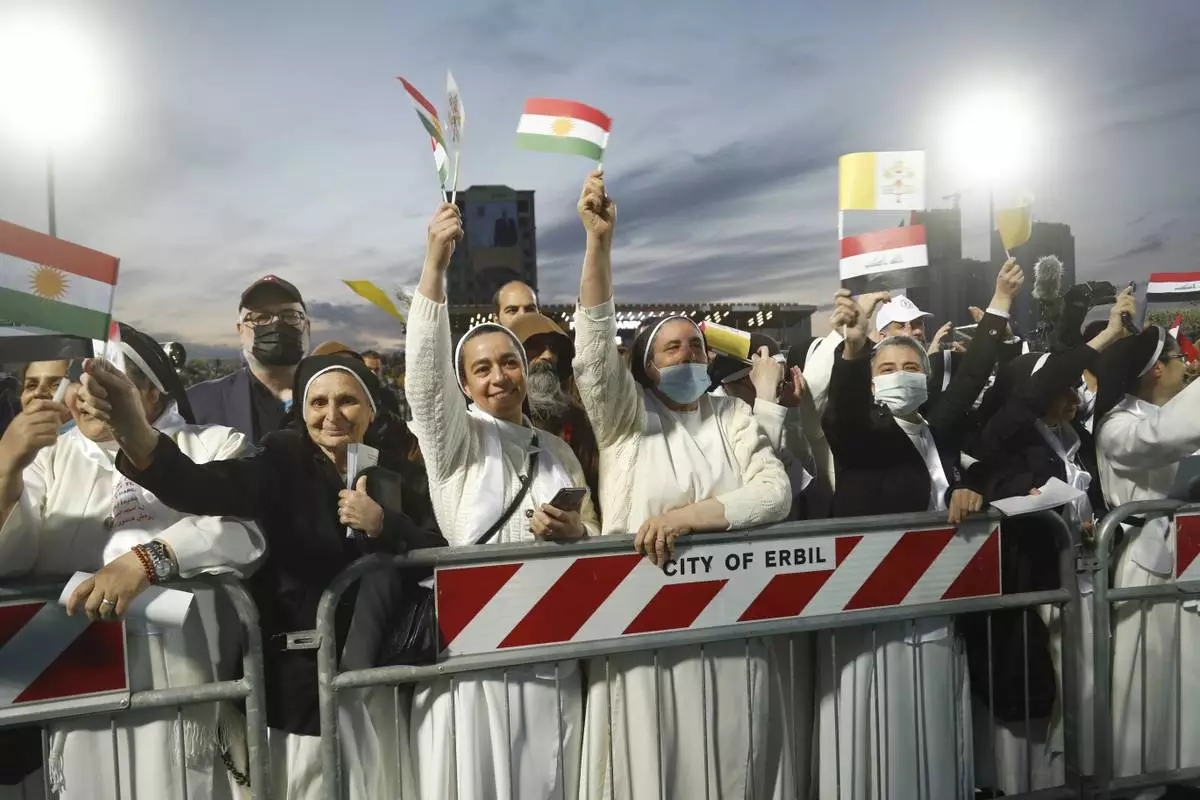
FILE.- Iraqi Christians say goodbye to Pope Francis after an open air Mass at a stadium in Irbil, Iraq, Sunday, March 7, 2021. (AP Photo/Hadi Mizban,File)
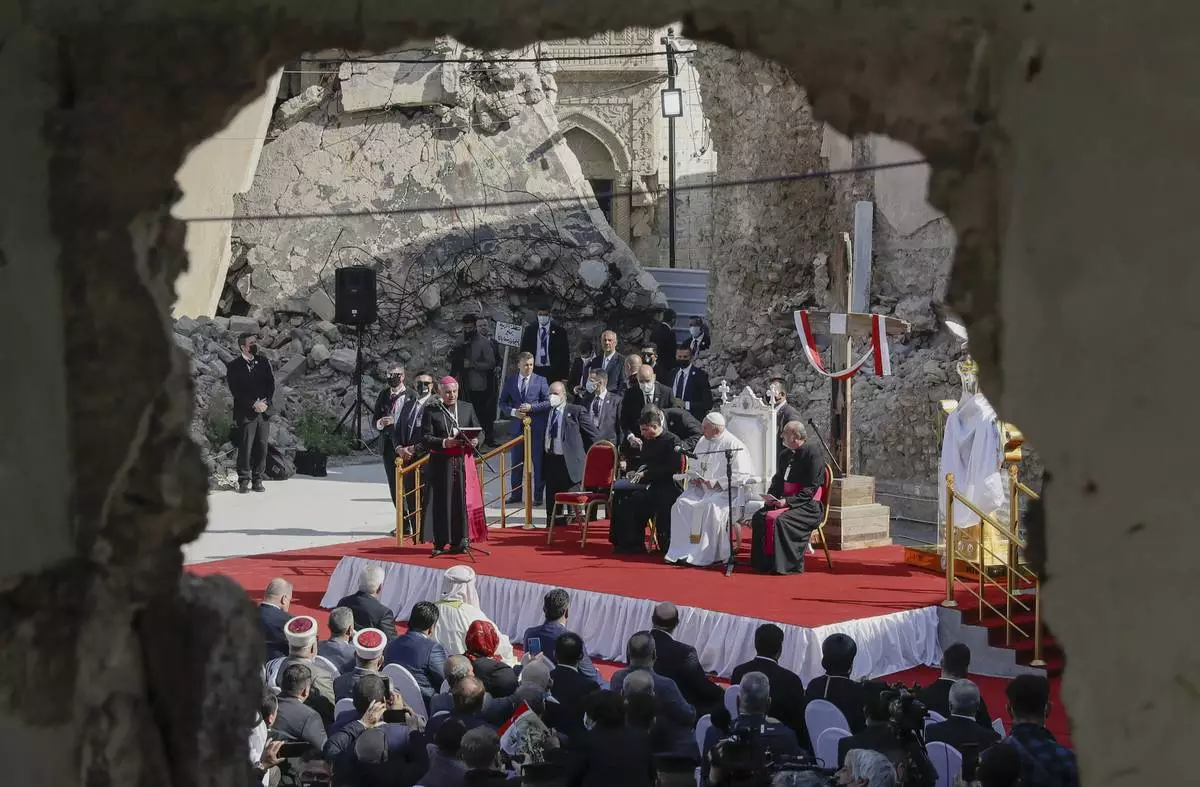
FILE.- Pope Francis, surrounded by shells of destroyed churches, listens to Mosul and Aqra Archbishop Najib Mikhael Moussa during a gathering to pray for the victims of war at Hosh al-Bieaa Church Square, in Mosul, Iraq, once the de-facto capital of IS, Sunday, March 7, 2021.(AP Photo/Andrew Medichini,FIle)















